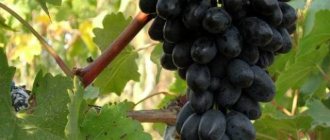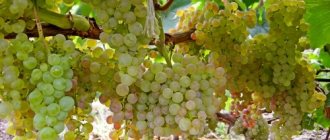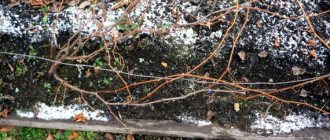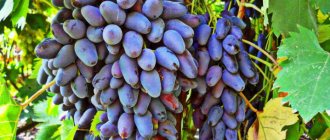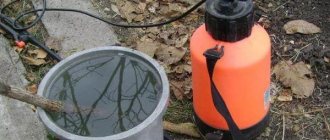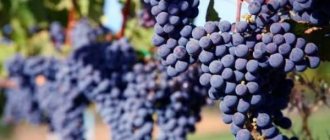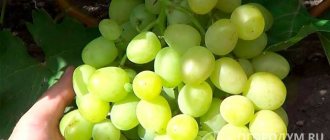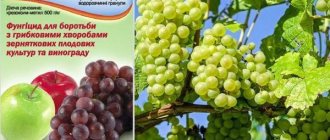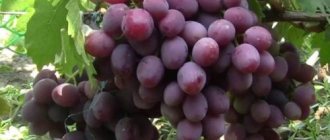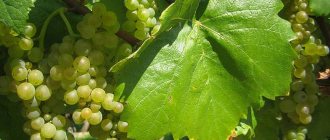Advantages and disadvantages
To successfully grow grapes, you need to know the advantages and disadvantages of the chosen variety.
Pros:
- Resistance to spider mites, phylloxera, mildew.
- Pleasant taste.
- Large brush size.
- High yield.
- Easy to care for.
Minuses:
- High degree of oidium damage.
- Susceptibility to attacks by birds and wasps.
- The variety is unsuitable for long-term storage and long-distance transportation.
Origin
The hybrid “Strashensky” (the second name is “consul”) has several “parents”: “friendship”, “katta-kurgan”, “dodrelyabi”, which alternately pollinated “muscat de Saint-Valier”. As a result, the resulting grapes became the bearer of all the best qualities of the listed varieties. A successful experiment was implemented in the 80s of the twentieth century by the breeders of the Moldavian Research Institute of Vital and Vital Plants: M. Zhuravel, G. Borzykova, I. Gavrilov, N. Guzun.
Parents of “Strashensky” are “friendship”, “katta-kurgan” and “dodrelyabi”
Grapes Strashensky (Consul) - what kind of variety it is, properties
Moldovan breeders developed a new variety, Straseni, which is classified as a table variety, and varieties such as Druzhba, Katta-Kuran, Dodrelyabi and Muscat de Saint-Valier participated in the breeding. The description of the characteristics is in many ways similar to the parent varieties.
Interesting! Strashensky grapes have a second name - Consul.
Despite the fact that the variety was bred back in the 80s of the 20th century, its popularity has not decreased at all, but rather even increased.
Description and characteristics, what it looks like
The bush and shoots of the plant are strong; each vine bears two clusters. The flowers are heterosexual, but male and female appear, which ensures sufficient pollination for a high yield.
The bunch weighs 1 kg, has a cone-shaped shape, and the berries on it are not very densely located. The grapes are oval in shape, weigh up to 14 g, and are colored dark purple. The taste is harmonious, with a slight sourness. The pulp is very juicy, fleshy, the peel is not noticeable. The yield is high; with proper care, about 30 kg of fruit can be collected from one bush.
Important! The variety tolerates frosts down to -23 °C and is resistant to drought.
Advantages and disadvantages
The Strasensky grape variety has many advantages, but at the same time there are also disadvantages that should be taken into account when planting it and while caring for the bush.
Winegrowers note the following advantages:
- high yield, large berries;
- tolerates transportation well, has a beautiful appearance;
- resistant to most diseases;
- frost- and drought-resistant;
- undemanding in care.
Among the disadvantages the following features are noted:
- It blooms for a long time, and therefore the berries ripen quite late;
- poorly stored, must be consumed or processed immediately;
- susceptible to gray mold and oidium.
Despite this, many gardeners grow this grape variety on their plots and are satisfied with the results. Many people love it for the extraordinary beauty of the clusters, and the bright shade will decorate any drink.
Scope of application
The main purpose of the Consul is fresh consumption; beautiful, juicy large berries have a high tasting score of 8 points. Despite this, the variety is widely used for home preparation and wine making.
Interesting! Strashensky is especially good when blended with other, more aromatic varieties. The resulting shade is striking in its beauty and attractiveness.
Main characteristics
“Strashensky” is a vigorous, high-yielding variety with a medium-late ripening period.
Ripening period
The growing season of this variety is 130 – 145 days. It belongs to the mid-early variety, although some winegrowers call “Strashensky” a mid-late variety. This difference in opinion is due to the region where the grapes are cultivated: depending on the geographical latitude, the first clusters can begin to be removed from the end of August to the end of September. It is also worth checking out other promising mid-early varieties, such as “radiant raisin”, “lady fingers” and “original”.
Bush
The Strashensky bush is considered vigorous and powerful. The growth of the vine per season reaches 2 - 3 meters.
The leaves are large, covered with down on the underside. The flowers are self-pollinating.
Important! The yield of “Strashensky” directly depends on the number of stepsons on the bush. Experienced winegrowers advise not to remove them, but, on the contrary, to leave them to form more leaves.
Bunches and berries
The clusters are large, their length can reach 50 centimeters, and their weight is 1 – 1.5, sometimes 2.2 kilograms. Medium density brush structure.
Dark purple, almost black berries are characterized by a round shape and a weight of 8 – 14 grams. The pulp is juicy and fleshy, the skin is thin, almost imperceptible when eating. Each grape contains 2–4 seeds, which do not spoil the taste characteristics of the fruit. The top of the berries is covered with a thin layer of pruin. The concentration of sugar in fruits is 18 - 19%, and acids - 7 - 8 g/l.
Taste
The taste of the variety is pleasant, harmonious, and when the berries are fully ripe, it is enriched with fruity notes.
Reference! Expert tasters rated the taste of “Strashensko” relatively highly – 8 points out of 10 possible.
Productivity
The yield of the variety is stable and high: annually up to 30 kg of appetizing fruits can be harvested from one bush of the variety, and on a production scale - up to 250 centners per hectare.
Diseases and pests
Powdery mildew
| |
Gray rot
|
Comparison with analogues
Below are comparative characteristics of the “Strashensky” grapes with other black table varieties of medium-early ripening.
| Sign | Variety | |||
| Strashensky | Nadezhda AZOS | Ataman | Velika | |
| Ripening period | 130 – 145 days | 115 – 130 days | 130 – 145 days | 130 – 135 days |
| Frost resistance | -17C | -26C | -24С | -22C |
| Productivity | Up to 30 kg | Up to 30 kg | Up to 20 kg | 9 – 10 kg |
| Bunches | 1 – 1.5 kg | 500 – 900g | 900 g – 2 kg | 600 g – 1.5 kg |
| Taste | Harmonious with light fruity notes | Harmonious | Harmonious and refreshing | Refreshing with prune flavor |
| Color | Dark purple | Dark blue | Dark purple | Dark purple |
| Disease resistance | Average | Above average | Above average | Low |
| Shelf life | Up to 1 month | 1 – 3 months | Up to 4 months | Up to 3 months |
| Sugar accumulation | 18 – 19% | 15 – 17% | 16 – 20 % | 18 – 19% |
| Acidity | 7 – 8 g/l | 7 – 8 g/l | 6 – 8 g/l | 6 – 7 g/l |
Description of the Strashensky grape variety
Despite the fact that this variety is a rather complex hybrid, it has typical morphological features inherent in grapes of temperate latitudes. But it must be taken into account that the plant has its own characteristics, which affect not only the agricultural technology of cultivation, but also further care.
Appearance
The Strashensky grape is a powerful, medium-sized, branched bush. The average height of the plant in optimal conditions can reach 2 m. Its shoots are strong, capable of quickly lengthening and overgrown with young branches. The level of shoot ripening is also high and is about 80%. The leaves are small or medium sized. The leaf blade is three or five lobed, rounded.
The flowers are medium-sized, bisexual, collected in small racemes. After flowering, cone-shaped brushes form on the bush, sometimes loose, but more often of medium density, weighing about 700–1000 g. The berries develop large, round, weighing 12–14 g. The color of the berries is rich, mostly dark blue, it can change when fully ripe to dark purple, almost black.
Taste qualities
The variety has high taste qualities. Its fruits are characterized by juicy and fleshy pulp, characterized by a harmonious taste. The sugar content of the berries is in the range of 19–22%, and the sourness does not exceed 8.5%. The skin of the berries is practically not felt when consumed.
Productivity
These grapes belong to medium-late ripening crops, which means that the plant enters the fruit-filling phase 130–145 days after the start of the growing season. However, this did not prevent the variety from becoming one of the most productive in the world. The average yield of Strashensky per 1 hectare is 20–25 tons, while about 20–35 kg of fruit can be collected from one bush during the growing season.
Useful properties and applications
The black Strasensky variety contains about 300 antioxidants , which neutralize free radicals, thereby strengthening the immune system and fighting malignant tumors. Resveratrol also performs the same function. Quertecin and flavonoids strengthen the walls of blood vessels, improve blood composition, destroy cholesterol plaques, and prevent the formation of blood clots. Pectin normalizes the functioning of the digestive system. A set of useful vitamins and minerals adjusts the functioning of the entire body in the right way, triggering all vital reactions.
Grapes are quite high in calories: 100 g of berries contain about 70 kcal. This should be remembered by those who are on low-calorie diets and are also prone to gaining excess weight.
“Strashensky” is suitable for fresh consumption; you can make jam and jam from it, or make homemade wine.
Features of cultivation
The rather low threshold of frost resistance makes it necessary to cover “Strashensky” for the winter, no matter in what region it is grown.
Boarding time
Planting seedlings of the variety is allowed both in spring and autumn. It is advisable to begin spring planting work in April, when the danger of return frosts has finally passed, the soil has warmed up to +10ºС, and the average air temperature does not fall below +15ºС.
Important! “Strashensky” begins to bear fruit already in the second year after it is planted in open ground, provided that all requirements for its care are met.
In autumn, planting work begins a month before the expected start of frost , but the winegrower should definitely take care of insulating the young bushes in advance, since anything can happen in nature, and frost can strike completely unexpectedly.
Place and soil
The best option for growing grapes is a sunny place, protected from gusts of cold wind. It is also important to pay attention to the depth of groundwater, and if it flows higher than 1.2 - 1.5 meters, then planting grapes is out of the question: there is a high risk of rotting the root system of the seedling or the development of infectious diseases.
The variety has no commitment to a specific type of soil, but it is quite natural that the more fertile the soil, the richer the harvest. It is quite rational to pre-enrich the soil before planting grapes by fertilizing it with a complex of nutrients.
If you plan to plant a seedling in the spring, then compost or humus is added in the fall when digging the soil. And 3 weeks before planting grapes in the fall, 1 bucket of organic matter (humus, peat) and 500 g of superphosphate should be poured into the prepared holes for planting.
The recommended dimensions of the planting pit are 80 centimeters in depth, width and length. The distance between adjacent bushes should not be less than 2.5 meters, and between rows - at least 3 meters.
Further planting technology is no different from the classical scheme: drainage to the bottom of the hole, a layer of nutrient mixture, placing the seedling deep, straightening its roots, covering it with soil residues, compacting the soil, abundant watering, mulching.
Watering and fertilizing
During the first month after planting, the young plant is watered as the soil dries out; as the plant takes root, the number of waterings is reduced. It is enough to water an adult bush 3 times in the warm season and once in the fall after harvesting (when planting on sandy soil, the number of waterings will have to be increased - once a month).
For greater fruiting, it is advisable to feed the variety. The fertilizer application scheme is standard: nitrogen in the spring, potassium and phosphorus in the summer, and organic fertilizers in the fall.
Trimming
Pruning is usually done by 4 - 6 buds, leaving at least 18 buds on each shoot. The largest clusters are formed at the second level. The recommended load per bush is 40 - 60 buds: the further north the growing region is, the fewer buds should be left on the bush.
Attention! The main feature is the uneven maturation of the brush: the upper one has already become fully usable, and the lower one is still green. To avoid such a situation, at the moment when the berries are just starting to set, a third of the brush is simply cut off. This will reduce the volume of the bunch and ensure uniform ripening of all berries.
Main diseases and pests
“Strashensky” is resistant to phylloxera and spider mites, slightly less resistant to mildew and rot, but the variety is completely vulnerable to oidium. To avoid unpleasant consequences from fungal diseases, grape bushes should be treated 3-4 times per season with fungicides, the last of which is carried out no later than a month before harvest. Do not forget about the standard requirements for plant care: mandatory collection of fallen leaves, autumn digging of soil, timely removal of weeds.
Wasps and birds cause a lot of trouble. The best option is special nets that are placed over the grapes. You can resort to sweet insect baits or special bird repellers.
Frost resistance
The frost resistance indicators of the variety are not at the highest level: -17ºС, maximum – 24ºС, subject to isolated cases of the thermometer dropping to such indicators. In this case, measures to insulate the vine are very relevant even in southern latitudes. To do this, the lashes are removed from the support, bent to the ground and covered with spruce branches, agrofibre, and earth.
Reference! One of the worst options for insulating grapes is using plastic film. With its help, you can create a greenhouse effect - fertile conditions for the proliferation of pathogenic microorganisms and fungi.
Harvest storage
“Strashensky” is not intended for long-term storage and transportation over long distances: the skin is too thin.
Regions of cultivation
The variety is recommended to be cultivated only in the southern regions due to low frost resistance and a fairly long period of berry ripening. Currently, these grapes are successfully cultivated in the south of Russia, Ukraine, Moldova, Armenia, the south of France and Italy.
Planting and care conditions
The quality of the purchased seedling is of no small importance, so it is necessary to purchase grapes only in specialized nurseries and preferably in the region in which the garden plot is located. The plant must be free of signs of damage and putrefactive defects.
Compliance with the necessary planting rules and providing the shoots with the conditions necessary for growth are the key to obtaining a decent harvest. Despite the fact that the variety is frost-resistant and can tolerate low temperatures in regions with cold climates, it is recommended to put it under shelter during the winter period.
To do this, the vines are removed from the supporting supports and placed under a protective structure until spring. This type of work is done before frost sets in. When forming a protective structure, it is important to take into account that the lack of air, humidity and excessive insulation will lead to the effect of “overheating” of the plant, which can negatively affect its condition in the spring or lead to death.
Pit depth and optimal placement of seedlings
Plantings are formed in spring or autumn; it is recommended to place them in even rows. A distance of 2.5 m must be maintained between shoots and 3 m between rows. A sufficient planting depth is considered to be 80 cm.
Koleria - growing, propagating, planting and replanting with your own hands. Secrets of care professionals (105 photos)
Before planting, you need to straighten the root shoots well, trim them and, if desired, soak them in a growth stimulator. At the time of planting, it is necessary to achieve uniform distribution of the roots inside the planting hole, then cover it with a layer of fertile soil and thoroughly water it.
The soil
Strashensky grapes are picky about the planting location and adequate lighting. It requires fertile soil and a lot of light, so for placement choose sunny southern areas, protected from gusts of wind. The plant does not tolerate stagnant water, so planting in areas close to groundwater should be avoided.
For light and sandy soils, it is not necessary to provide a drainage layer, since they allow moisture and oxygen to pass through well. Dense types of soil require intervention and adjustment of their qualities. Drainage made of crushed stone, crushed brick or coarse sand will help improve the quality of soil permeability and avoid stagnation of water.
Watering
The Strashensky variety is moisture-loving, so it requires regular, abundant watering. After planting the seedlings, the soil is moistened once every 7 days; after harvesting, the frequency is reduced to once a month. Excessive humidity may cause the grapes to crack.
Fertilizer
The nutritional value and fertility of the soil directly affect the fruiting rates of grapes. To improve the quality of the soil, fertilizers are applied. The first work is carried out in the fall, adding humus or compost when digging. When planning to plant seedlings in the fall, the fertilizer complex is applied to the holes 3 weeks in advance. When planting in spring, add 1 bucket of organic fertilizer and 1 g of superphosphate to one hole.
Pruning and shaping the vines
Grapes of this variety are characterized by a long flowering period, which often negatively affects the ripening period of the fruit. To prevent such a problem, remove the first grape tassel on each bush.
Due to the fact that the variety is high-yielding, the shoots tend to suffer from overload.
To maintain proper plant health, it is necessary to cut off empty flowers and unformed buds. It is considered optimal for grapes to have no more than 18 eyes on one shoot. Pruning of grapes is carried out in a standard way. From 4 to 6 eyes are left on the shoot, taking into account that the largest clusters are formed at the second level.
Pollination
The hybrid produces flowers of both sexes, so the presence of female and male inflorescences allows only this variety to be planted on the site. For fruiting, Strashensky does not require planting other grape crops.
Flowering and fruiting period
The flowering and ripening of Strasensky grapes is delayed in time, which is due to the large size of the bunches. Often there is a situation where the top ones have already stopped blooming, and 1/3 of the bottom ones are just starting the process. A similar situation is observed during the period of fruit ripening.
The period of fruit production, depending on the growing region, ranges from 130 to 145 days. Their color change occurs gradually. The first signs of color acquisition are observed already in mid-July, which becomes more saturated by the end of the month. Ripening lasts for 2 weeks and the harvest can be harvested from the second week of August. The exact timing may vary slightly depending on the region and climatic conditions of cultivation.
Photo
Below are photos and reviews about the Strashensky variety.
Reviews
The Strashensky that I tried, frankly speaking, did not impress me in terms of taste, but the appearance was very impressive. Vitaly, Uzhgorod
Every year I harvest almost half a bunch. Otherwise, you’ll have to wait a long time for everything to ripen. Another drawback is cracking. Semyon Ivanovich, Kremenchug
For me it does not crack and the yield is high. I regret that there is only one bush. Good grapes. Georgy, Pavlograd
